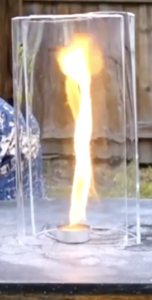Carlos Vega
March 12, 2019
Abstract:
When tornadoes are form is due to a rotation in the air, with hot air trapped underneath cold air. In this lab we will study the effects that different cold air intakes affect the size(height) of the vortex. It was performed by creating a system where cold air rushed into a specific section of hot air in a rotational motion. After the experiment was concluded, it was found that the main factor depends on the amount of heat produced by the combustion agent could be combined with the equivalent amount of cold air.
Introduction:
According to Harold Brooks, “More than 18,000 people died from tornadoes between 1875 and 2000” .Having a better understanding of tornados helps us prevent the damage that could occur by being prepare beforehand, and also possibly prevent them from happening in the first place. In essence, tornadoes are caused by an interaction of cold air and hot air. Since the hot air is less dense, this makes it so the hot air tries to rush out above the cold air, dispersing it in the process. This process combined with any slight rotation in the air creates the vortex known as the tornado.
With fire tornadoes, the scenario in which they develop is when a combustible material interacts with this “hot-cold” air system causing fire within the vortex. California’s latest firenado was so devastating that it was the cause of six lives and destroyed thousands of structures, as reported by Cal Fire. This lab was created specifically to study and understand fire tornadoes and what could affect the magnitude and effectiveness of the vortex. The hypothesis is that a fire tornado would form as long as there is a rush of cold air interacting in the hot air of the system.
Objective:
The objective of this lab is for us to gain a better understanding of the relationship between the magnitude of a vortex as the air flow fluctuates within the system. We will analyze the magnitude of the tornado by measuring the difference in height, and the amount of airflow will be the variable changed during the whole procedure.
Materials:
Glass cylinder
Rotary tool
Tabletop
91% Isopropyl alcohol
Lighter
Candleholder
Ruler
Procedure:
- Cut a glass cylinder down its diameter with a rotary tool in order to get to equal semi-cylinders. Make sure the procedure is done with running water as this would prevent any thermal shock due to friction. Also, mark one line that follows the circumference of the cylinder slightly above its base.
- Put the candleholder on the tabletop and pour isopropyl alcohol inside the candleholder so that it is only half-full. This is for the safety of the lab practitioner.
- Using a lighter, light the isopropyl alcohol inside the candleholder on fire. This fire will be the medium through which the vortex will be observed.

- Position both semi-cylinders such that they are off center from one another, this will create 2, .5cm opening on the opposite sides while encasing the candle holder with the isopropyl in the middle. Make sure there are no gaps in between the two pieces of glass. Observe any possible changes to the fire. The vortex should form once the pieces of glass allow air. Repeatedly increase the gap in between the cylinders by 0.5 cm. Each time, record the height of the flame at a new increment. This will measure the magnitude of the vortex as a function of how easily air flow can occur through the system.
Results:
We observed how the fire tornado manifested itself fully as it was encased within the glass cylinder apparatus we created, the fire began to increase in height and rotate in a circular motion as soon as the pieces of glass were offset. The height of the fire remained moderately the same through the whole experiment as there weren’t any mayor changes in the height despite of our changes in the length of the gap.
| Gap between semi-cylinders | Height of fire |
| 0.0 cm | 8 cm |
| 0.5 cm | 15.0 cm |
| 1.0 cm | 15.0 cm |
| 1.5 cm | 14.5 cm |
| 2.0 cm | 9 cm |
| 2.5 cm | 0.0 cm |
As the gap was increased passed 2.0 cm we noticed a massive drop off on the height of the tornado, the rotations became less noticeable within the fire and the height of the flame began to decrease and after 2.5 cm, the fire began to die out completely.
Analysis:
As hypothesized, a vortex was formed as soon as the cold air that surrounded the glass enclosure was allowed into the system by opening the gaps between each semi cylinder. This occurs due to the higher pressure of the cold air which makes it denser than hot air, therefore this led to reduction of the pressure imbalance within the system. Since the system has a cylindrical shape, the cold air was moving uniformly in a circular motion within the system. The hot air within the system has a lower pressure which traveled at an upward direction. This exact upwards motion is what leads to our desired outcome of the vortex as it is combined with the rotational motion and an intake of dense cold air.
Reference List
| [1] | H. Brooks, “A Brief History of Deaths From Tornadoes In The United States,” January 2001. [Online]. Available: https://www.nssl.noaa.gov/users/brooks/public_html/deathtrivia/. [Accessed 1 November 2018]. |
| [2] | B. Robertson, “Science 101: What causes severe thunderstorms and tornadoes,” October 2016. [Online]. Available: https://web-a-ebscohost-com.ccny-proxy1.libr.ccny.cuny.edu/ehost/detail/detail?vid=0&sid=1e503696-87fd-4a23-809b-2be377c2271b%40sessionmgr4010&bdata=JnNpdGU9ZWhvc3QtbGl2ZQ%3d%3d#AN=118363257&db=eue. |
| [3] | D. Rice, “California ‘fire tornado’ had 143 mph winds, possibly state’s strongest twister ever,” USA TODAY, 2018. |
| [4] | Kevin, “YouTube,” TheBackYardScientist, 20 November 2016. [Online]. Available: https://www.youtube.com/watch?v=1BxQd6AGYiI. |


